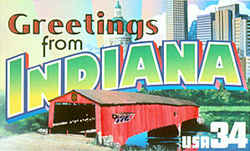


Indiana Early History
First Early Inhabitants of Indiana

Early history examines the archaeological record that tells the story of the first inhabitants of Indiana. Learn about the prehistory and culture of the first early inhabitants, and what lessons it might teach us about the early history of Indiana.
Indiana First Early Inhabitants Timeline
- Prior 10, 000 BC - During the Pleistocene period, also known as "THE ICE AGE," much of Indiana was covered by ice.
- 10, 000 BC - ca. 8000 BC - After the Thaw. Prehistoric American Indians may have been in Indiana as long ago as 11,000 BC
- Paleo-Indian era: Archaeological evidence includes man-made projectile points
- Archaic Indian era: Archaeological evidence includes the mussel shell mounds in southwestern Indiana.
- 1000 BC - 900 AD - Woodland Indian era: Archaeological evidence of cultivation, ceramic pottery, and burial mounds like those at Mounds State Park near Anderson, IN.
- 900 AD - ca. 1650 AD - With Archaeological evidence of extensive cultivation and large permanent community settlements such as found at
Angel Mounds State Site near Evansville, IN. Angel Mounds State Historic Site was a Mississippian Indian town inhabited between 1100 - 1450 AD Was
this the land of Casqui and Pacaha reportedly described by De Soto in 1539?
- Mississippian Indian era: with Archaeological evidence of extensive cultivation and large permanent community settlements such as found at Angel Mounds State Site near Evansville, IN. Read Angel Mounds at Evansville, Indiana, a Formal Report by Dr. Glenn A. Black
- Angel Mounds State Historic Site - a Mississippian Indian town (1100 - 1450 AD) Was this the land of Casqui and Pacaha reportedly described by De Soto?
- [Mysterious Disappearances of the Amerindians Mound People - the end of the Mississippian Era. (from neighboring Missouri area archaeology site)
- 1500 - Indiana was first explored by the French
- 1539 - Spanish Conquistadors in North America (De Soto from 1539) Organization of pages Midwest Conquest Trails - Indiana
1541 Hernando de Soto (1500-1542) explores Indiana. De Soto and his army are reported to have entered the town of the lord of Casqui (Vincennes)
Early History of Native Americans Indiana
The Indigenous People of Indiana
The names of the Indiana tribes included the Illinois tribe (Illini), Chippewa, Lenape (Delaware), Erie, Iroquois, Kickapoo, Potawatomi and Miami. Indiana's earliest inhabitants were groups of Native Americans known as Mound Builders. Some of these prehistoric people were hunter-gatherers. Others were sedentary farmers. The mounds they left behind were constructed as burial sites, temples, platforms for religious structures, and earthen forts.
Indiana's earliest inhabitants were groups of Native Americans known as Mound Builders. Some of these prehistoric people were hunter-gatherers.
Others were sedentary farmers. The mysterious disappearance of the Amerindians Mound People occurred at the end of the Mississippian Era.The mounds
they left behind were constructed as burial sites, temples, platforms for religious structures, and earthen forts.
When European explorers entered the region in 1679, only a few hundred Native Americans remained. Most belonged to the Miami tribe. Native American
Indians migrated west into Indiana as European settlers took their lands during the late 1600s. The Shawnee, Miami, Delaware, Mahican, and Potawatomi
tribes were just a few of these tribes.
During the 1700's and 1800's many other tribes came to Indiana from the East, after losing their lands to white settlers. These included the Delaware,
Mohican, Munsee, and Shawnee. Others, the Huron, Kickapoo, Piankashaw and Potawatomi, came to the region from the Great Lakes area to the north.
The Potawatomi were the last group of Native Americans to enter Indiana and the last to leave. They built villages in the northeastern part of the
region in the late 1700's, but by 1838, few remained. Many sold their land to the government. Others were driven out by the military.





